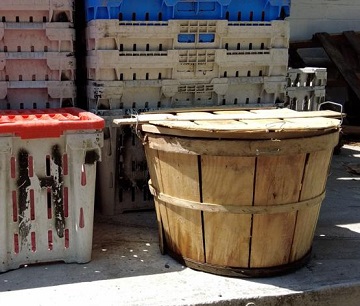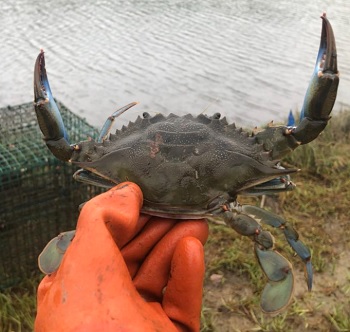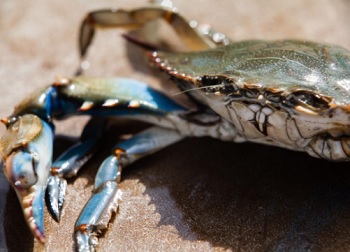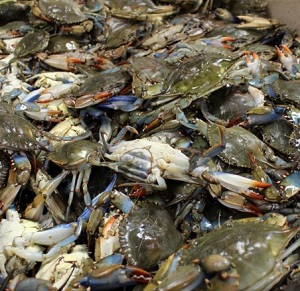Tag Archives: Blue Crab
Beaufort’s cherished blue crab is ‘mean as hell.’ But crabbers love catching them
 “They’re a delicacy,” says Everett, a St. Helena Island-based commercial crab fisherman, “but they’re mean as hell.” South Carolina’s coastlines are dominated by vast salt marshes with dense stands of smooth cordgrass and oyster reefs drenched twice daily by tides up to 8 feet. It is a perfect habitat for delicious blue crab, that hide in the grass feeding on oysters, clams and snails — anything they can get their vicious claws on. Sometimes, the cantankerous crustaceans burrow into the mud with only their beady “eye stalks” visible lying in wait for a passing meal. But if they’re not careful, the crabs, an important link in the food chain, will become a meal themselves for birds and fish — or caught by crabbers like Everett. more, >>CLICK TO READ<< 08:17
“They’re a delicacy,” says Everett, a St. Helena Island-based commercial crab fisherman, “but they’re mean as hell.” South Carolina’s coastlines are dominated by vast salt marshes with dense stands of smooth cordgrass and oyster reefs drenched twice daily by tides up to 8 feet. It is a perfect habitat for delicious blue crab, that hide in the grass feeding on oysters, clams and snails — anything they can get their vicious claws on. Sometimes, the cantankerous crustaceans burrow into the mud with only their beady “eye stalks” visible lying in wait for a passing meal. But if they’re not careful, the crabs, an important link in the food chain, will become a meal themselves for birds and fish — or caught by crabbers like Everett. more, >>CLICK TO READ<< 08:17
Virginia Moves To End 16-Year Ban On Dredging For Crabs During Winter
 Virginia’s fishery managers have lifted the longstanding ban on dredging for blue crabs during the winter in the Chesapeake Bay, a seismic policy shift that drew strong criticism from their Maryland counterparts and conservationists. The Virginia Marine Resources Commission voted 5–4 on June 25 to repeal the 16-year prohibition on winter dredging. The board is expected to reconvene in September to consider staff recommendations on how to implement the fishery. The new season could open as early as this December. The board’s action came after the VMRC’s Crab Management Advisory Committee, which is mostly made up of industry members, voted 10–2 in favor of reopening the winter season. After that May 29 vote, the agency received 186 public comments on the proposal — all in opposition. more, >>CLICK TO READ<< 16:12
Virginia’s fishery managers have lifted the longstanding ban on dredging for blue crabs during the winter in the Chesapeake Bay, a seismic policy shift that drew strong criticism from their Maryland counterparts and conservationists. The Virginia Marine Resources Commission voted 5–4 on June 25 to repeal the 16-year prohibition on winter dredging. The board is expected to reconvene in September to consider staff recommendations on how to implement the fishery. The new season could open as early as this December. The board’s action came after the VMRC’s Crab Management Advisory Committee, which is mostly made up of industry members, voted 10–2 in favor of reopening the winter season. After that May 29 vote, the agency received 186 public comments on the proposal — all in opposition. more, >>CLICK TO READ<< 16:12
Virginia’s blue crab commercial harvest period extended
 The Virginia Marine Resources Commission voted last week to approve the extension recommended by the Crab Management Advisory Committee. The harvest of crabs by hard crab pot is now Dec. 16, pushed back from Nov. 30. Lower bushel limits will begin Nov. 1 instead of Oct. 1. The purpose of these changes is to promote efficient utilization of blue crabs and economic stability for the fishing industry, according to the Marine Resources Commission. “Female crabs are not overfished, and overfishing is not occurring on them,” said Alexa Galván, a fisheries manager with the commission during a VRMC meeting. “But, the 2021 and 2022 exploitation rates were slightly above the target, not of the threshold which would be overfishing.” >>click to read<< 12:50
The Virginia Marine Resources Commission voted last week to approve the extension recommended by the Crab Management Advisory Committee. The harvest of crabs by hard crab pot is now Dec. 16, pushed back from Nov. 30. Lower bushel limits will begin Nov. 1 instead of Oct. 1. The purpose of these changes is to promote efficient utilization of blue crabs and economic stability for the fishing industry, according to the Marine Resources Commission. “Female crabs are not overfished, and overfishing is not occurring on them,” said Alexa Galván, a fisheries manager with the commission during a VRMC meeting. “But, the 2021 and 2022 exploitation rates were slightly above the target, not of the threshold which would be overfishing.” >>click to read<< 12:50

Reins Loosened Slightly On Chesapeake Bay Crab Harvest
“We’re being cautious, but I think we’re being responsible,” said Ed Tankard, a board member with the Virginia Marine Resources Commission, which voted June 27 to ease certain bushel limits. In Maryland, the state Department of Natural Resources announced on the same day a raft of industry-friendly changes to its crab controls, including modestly increasing the allowable harvest of female crabs and lifting limits on the harvest of males over Labor Day weekend. Those moves came a few weeks after the panel that regulates the Potomac River’s fishing industry agreed to roll back bushel limits on female crabs to 2021 levels. >click to read< 12:21

Proposed Pilot Program For Female Blue Crabs
A new pilot program introduced by the Department of Natural Resources has watermen frustrated. It’s with the possible implementation of plastic, rectangular containers called lugs. Currently, caught male blue crabs are able to be placed in lugs, but females are not. So watermen feel the program comes with a lot of hoops to jump through and they ask why the need for the program at all. Lugs are bigger than your typical bushel basket of crabs. Bushels hold about 40 pounds and lugs hold 60. DNR has introduced the idea of using lugs for female crabs. But with that comes rules that participating watermen (in the pilot program) must follow. >click to read< 12:30

Lowcountry is the last ‘wild west’ for blue crabs. Crabbers call for change.
In February, David Richardson drove to Columbia from his home in Charleston to speak to a room of state senators about his life as a South Carolina crabber, which, at the moment, “is kind of miserable.” But it wasn’t always miserable. Which is why he drove two hours to the Statehouse, a place he had never been nor expected to visit. The crabber thought about wearing a Hawaiian shirt, then thought twice: “I wore a suit, thank God.” As crab numbers fell over the past decade across the Eastern Seaboard, South Carolina did nothing, but North Carolina increased its management actions. It designated some areas as “no-fishing” spawning sanctuaries. And Georgia decided to limit the number of commercial crabbing licenses to under 100. Photos, >click to read< 08:39

Surprising Blue Crab Population Develops In Maine
Up in the Gulf of Maine, outside the crabs’ historic range, these creatures are a source of surprise. But over the past few years, it has become more and more common for people to find blue crabs. Lobster fishermen and women are catching them in their lobster pots. Divers are seeing them when they search for scallops. Beachgoers are spotting them in tide pools. “We don’t want to make claims yet that this is a permanent population,” Crane said. “If we’re finding blue crabs for five or ten years in the same locations, that starts to be a more compelling argument that this is a permanent population.” >click to read< 15:24

Chesapeake Bay blue crabs in trouble, tighter harvest restrictions loom
With the Chesapeake Bay’s crab population at its lowest ebb in more than 30 years, Maryland and Virginia are moving to curtail harvests in one of the region’s most valuable fisheries. Fisheries regulators in both states have proposed new catch restrictions, with plans to finalize them by the end of June. In Maryland, tighter limits for both commercial and recreational crabbing would take effect in July and for the first time would limit commercial harvests of male crabs, not just females. New commercial restrictions in Virginia would begin in October and continue until the crabbing season ends Nov. 30. >click to read< 08:17

North Carolina commercial fishermen landed less seafood last year
In 2020, 42.9 million pounds of fish and shellfish were sold, a decrease of 19% from 2019 and about a 23% decrease from the previous five-year average, according to the Division of Marine Fisheries. The decrease in commercial harvest was linked to a 41.3% decrease in hard blue crab landings from 2019, which may be related to COVID-19 impacts. The Division of Marine Fisheries said several fishermen told officials that they found it difficult to move blue crabs at the beginning of the state’s stay-at-home order when many restaurants were closed. >click to read< 15:26

‘Forever chemicals’ found in Chesapeake seafood and Maryland drinking water
More testing has found so-called “forever chemicals” in a striped bass, blue crab and oyster from the Chesapeake Bay,,, Eleven different PFAS compounds were also detected in tap water sampled from three homes in Montgomery County,,, PFAS are a group of more than 8,000 chemical compounds used in nonstick cookware, flame retardants, water-repellant and stain-resistant clothing and furniture, as well as in fire-fighting foams used at airports and military bases. They do not break down in the environment. They also spread easily through water and can build up in animals or organisms that ingest them, including people. >click to read< 18:04

Fishers have elected to limit quotas for Blue Crab and Rock Lobster in SA
Primary Industries and Regional Development Minister Tim Whetstone said the two revised plans will see fishers make short term sacrifices to allow crab and lobster populations to grow for the long-term benefit of all fishers, seafood consumers and the environment. “The government is committed to growing SA’s seafood industry and ensuring we have sustainable fish stocks for future generations,” he said. “There has been strong growth in Blue Crab and Southern Rock Lobster populations as a result of our fishers’ sustainable practices. >click to read< 09:29

Female Blue Crab Population Up In Chesapeake Bay, Juvenile Numbers Low
Chesapeake Bay blue crab population appears to have a healthy number of spawning-age female crabs, according to the 2020 Blue Crab Winter Dredge Survey. Maryland, Virginia and the Potomac River Fisheries Commission aims to conserve more than 70 million adult female crabs annually to ensure enough young crabs can be produced to sustain the population, a task that has now been achieved for the sixth consecutive year. This year’s survey estimates 141 million adult female crabs were conserved, which is above the long-term average of 126 million. The total amount of blue crab in the Chesapeake Bay in 2020 was 405 million crabs,,, >click to read< 14:56

A life hooked on uncertainty – Delaware fishermen just hoping they can survive impacts of the coronavirus
Brian Hoffecker almost didn’t make it through the first year he ventured off on his own as a commercial fisherman. It was the mid-1990s and he owed a lot of money on the boat he had just bought when a historic winter storm hit his prey – Delmarva’s iconic blue crabs – hard. “When it was time to go crabbing, I was broke,” he said. “It was brutally cold and it killed most of the crabs. There weren’t any crabs to catch.” After more than two decades making a living on the water, the impacts of the coronavirus, Hoffecker’s livelihood is threatened once again.,, Like commercial lobsterman and black sea bass fisherman Wes Townsend says, the only thing certain in the world of fishing is the uncertainty.,, But he’s never seen anything like this before, he said. photos, video,>click to read< 09:21

Chesapeake Bay: Targeting male blue crabs for harvest is preventing female crabs from having offspring
The Bay’s crab fishery is currently regulated to limit the harvest of female crabs, in a so-far successful effort to ensure that enough survive to reproduce and maintain the crustacean’s overall abundance — and sustain the estuary’s most valuable fishery. But researchers have wondered — and even worried at times — if harvesting more male crabs (or jimmies, as watermen call them) than females could be having an impact on the population. >click to read< 17:27

North Carolina: New blue crab management plan in the works
N.C. Marine Fisheries Commission recently announced it is moving forward with management measures for the blue crab that are designed to end overfishing. One of the biggest proposed changes is establishing closed seasons for the harvest, said Jason Rock, biologist supervisor with the Division of Marine Fisheries. >click to read< 15:09

Louisiana Dept. of Wildlife and Fisheries: report of loss linked to Bonnet Carre Spillway opening
“This is the worst I’ve ever seen it in my life,” Shrimper Charles Robin said. Robin is a shrimper in Yscloskey. He said his catch dropped by more than half this year compared to last. “Last year on average I’d catch a thousand or 1,200 pounds a day on a slow day. Now, you can’t even catch 500 pounds,” Robin said. According to Wildlife and Fisheries, brown shrimp landings are down 34 to 44 percent compared to the five year average. St. Bernard Parish President Guy McInnis said he’s actively pushing for an Emergency Fisheries Declaration in Washington, D.C. Video, >click to read<16:33

Chesapeake crab count up, but fewer watermen catching them
Stocks of blue crab in the Chesapeake Bay are up from last year by an estimated 60 percent, the best it’s been in six years, according to a group of experts from state and federal agencies and academic institutions. “The winter dredge survey results indicate a strong year ahead for blue crab,”,,, And while that’s good news for watermen, there are fewer of them actually out fishing for crabs in the Chesapeake Bay and its tributaries. >click to read< 18:48

‘I’m out of work:’ Open Bonnet Carre Spillway hurts local fisherman
The Bonnet Carre Spillway is currently open to keep the Mississippi River from overflowing and damaging the levee system. But crab fisherman say there’s another side to the water diversion: The longer it stays open, the more damage it will do to the fishing industry. Fisherman along Lake St. Catherine say this time of the year their traps are usually brimming with crabs, but Saturday when Eyewitness News came to look, most of the traps had been pulled out of the water. >Video, click to read<15:16

Chesapeake Bay blue crab rebounding in 2019, led by near-doubling of juvenile crab population
Scientists in Maryland and Virginia found that in 2019, the bay’s crabs are at their most plentiful in seven years. The number of spawning-age females, a key measure of future population growth potential, reached 190 million, a 29% increase over the previous winter.,,, The results suggest a strong crabbing season is ahead for Chesapeake waterman, with strong numbers of adults ready to be harvested as waters warm this month, and a booming crop of young that could grow large enough to be legally caught by the fall, or the 2020 crabbing season. >click to read<13:31

New experiment raises possibility of fresh N.C. soft-shell crabs year-round
An experiment to farm soft-shell crabs in North Carolina ponds could augment declining wild stocks and lead to having plenty of the delicacy fresh almost year round. Scientists from North Carolina and Mississippi will work together in a three-year venture to raise blue crabs and harvest them for the lucrative soft-shell market. Fresh soft crabs flood the market typically in May and June, at the height of molting season. A $339,239 grant from the National Oceanic and Atmospheric Administration will fund the project, managed by Sea Grant programs in both states. >click to read<20:24

Watermen get say on how to tackle ‘ghost pots’ in the Chesapeake Bay
“Ghost pots” remain a menace in the Chesapeake Bay, but how big a menace and what to do about them is anybody’s guess. That could change now that the 1,056 hard crab fishermen licensed in Virginia are getting a chance to have their say. Researchers at the Virginia Institute of Marine Science are mailing surveys to watermen asking for their ideas on the countless crab pots that, for any number of reasons, end up haunting the bay, trapping and killing crabs and other hapless creatures that crawl or swim inside. >click to read<14:58

Once in a blue moon: Crabber catches rare all-blue blue crab
Jim McInteer and his crew mate Alan Payne knew they had captured an oddity the moment they pulled their crab pot from the York River last Tuesday. “We were excited about it,” says McInteer. “Alan yelled, ‘Come look at this crab!’ He very carefully took him out of the pot and then I could see exactly what it was — I’d read about how they occur every now and then, so we knew what we had.” McInteer, who at 73 has been crabbing commercially for 10 years and recreationally for decades, says he’s caught blue crabs “with blotches of white, and some other slight discolorations, but never a solid-blue blue crab.”Recognizing its rarity, they donated it to the laboratory of Professor Rom Lipcius, an expert in crustacean ecology at William & Mary’s Virginia Institute of Marine Science. >click to read<16:19

Love Blue Crabs? Meet the Red Crab
If blue crab is this region’s Beyoncé, Atlantic deep-sea red crab is the backup singer you’ve never heard of. Found about 2,000 feet below sea level, these crustaceans are harder to harvest than their Chesapeake cousins. Plus, only one East Coast company is licensed to catch them. “I’ve been in business for 22 years, trying to put red crab on the map,” Atlantic Red Crab Company founder Jon Williams says. “It’s very well received when there’s no blue crab around, but as soon as blue crab becomes available, we take a second seat.” >click to read<21:18

Blue crab population declines by almost 18%
The annual Blue Crab Advisory Report by the Chesapeake Bay Program and developed by the Chesapeake Bay Stock Assessment Committee, finds that the overall Chesapeake Bay blue crab population decreased by almost 18 percent from 455 million in 2017 to 372 million in 2018. The report, released last month, provides scientific analysis of the Bay’s blue crab population to help resource managers as they set blue crab fishing regulations.,, According to the report and the scientific reference points that resource managers follow for “target” (healthy) and “threshold” (border between safe and unsafe) levels, the Bay’s blue crab population is currently not depleted, nor is it being overfished. >click to read<20:12

Blue crab population in Chesapeake Bay down for second year
The blue crab population in the Chesapeake Bay declined by nearly one-fifth for the second year in a row, with the male population hitting a trigger point that has lead to discussions over management, according to a new report. Experts say the overall stock remains healthy and decline is not cause for immediate concern, but that they are closely watching the numbers. The harsh winter coupled with a scarcity of young crabs last year has contributed to the low numbers in the beginning of the crab season,,, >click to read<13:04

Shrimp pass hard-shell crabs as North Carolina’s most lucrative seafood
Hard shell blue crabs had been the state’s leading seafood in pounds caught and in dockside value for decades. They still lead in pounds caught, but shrimp have taken over for the first time as the most lucrative seafood in North Carolina. Last year’s shrimp value came in at $29.6 million, besting crabs by nearly $12 million. In 2016, the shrimp sold for $28.2 million, again beating crabs. The 2017 shrimp catch reached 13.9 million pounds and 13.2 million pounds the year before that. Both years set new records. Hard crabs are being overfished, said Jason Rock, a state marine fisheries biologist.,,, Commercial fishermen disagree with the state’s alarm. >click to read< 12:03

Chesapeake Bay’s blue crabs made it through tough weather, survey finds
Despite the seemingly unending winter weather, Maryland found that the population of blue crabs in the Chesapeake Bay are “healthy and sustainable.” According to this year’s Blue Crab Winter Dredge Survey from the Maryland Department of Natural Resources, even though around 35 percent of adult female blue crabs didn’t make it through the cold, icy weather, there was a marked increase of young crabs returning to the bay this year. “The population is showing more resiliency to those ups and downs and those stresses,” said Chris Moore, senior regional ecosystem scientist with the Chesapeake Bay Foundation. >click to read<23:36














































